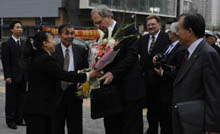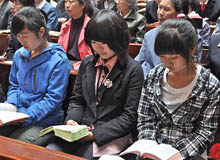Finding Faith in China:
A Vibrant Church in the Northeast
Read Report 1 & Report 3
 ive hundred believers crowded the aging sanctuary in Shenyang as the General Conference president described the final counsel Jesus gave His disciples on the night they celebrated Passover together in the Upper Room.
ive hundred believers crowded the aging sanctuary in Shenyang as the General Conference president described the final counsel Jesus gave His disciples on the night they celebrated Passover together in the Upper Room.
 In a literal upper room two stories above, another 500 believers jammed an overflow chapel, watching the service below on a single 26-inch closed-circuit TV screen.
In a literal upper room two stories above, another 500 believers jammed an overflow chapel, watching the service below on a single 26-inch closed-circuit TV screen.
Two hundred more worshippers lined every hallway and stairway, out of sight, but listening intently to the music and words that drifted down the corridors from the bullhorn-style speakers trailing long wires.
On the fourth day of a seven-day trip to the People’s Republic of China, Jan Paulsen and a team of General Conference and Northern Asia-Pacific Division leaders worshipped with two large Adventist congregations in this city of seven million. Overflow crowds of 2500 at the Beiguan Church and 1200 at the Beishi congregation greeted the president with applause, banners, and special choral anthems as he made his first visit to China since becoming church president 10 years ago, and the first any General Conference president has made to mainland China in more than 60 years.
“Half of us are here, half are two stories further up, and ten percent are sitting in the stairs,” said Paulsen, clearly moved by the outpouring of affection as he surveyed the crowded afternoon service at Beishi. “And maybe there are some out there who are saying, ‘I wish I were there, but there’s no room today, and we won’t go.’ But I want to honor you for your faithfulness, for your trust in God, and for your devotion.”
|
 Pastor Paulsen receives a bouquet from senior Pastor Hao Ya-Jie at the church entrance. [Photo: Glenn Mitchell/NSD] |
|
The two congregations in Shenyang illustrate the dynamics of the Adventist Church in China, where the denomination operates under different structures than in most of the world. The Beiguan Church, with nearly 3000 members, worships in an in a beautiful building often visited by government-sponsored tour groups. Completed in 2003, the modern sanctuary occupies a choice location in a newly-built neighborhood. Four miles away, the Beishi congregation shares an aging, overcrowded structure with a Sunday-keeping Protestant church in a densely-packed tangle of shops and homes that presses in around the church.
Both congregations, however, are historic “mother” churches, responsible for planting and nurturing dozens of smaller Adventist congregations that spread across this northern industrial city about 100 miles from the North Korean border. One hundred seventeen congregations serving a total of 7000 Adventists are coordinated by the Beiguan church in a manner much like that of a local conference in the rest of the world church. Seventy smaller churches and “meeting points” gather around the ministry of the Beishi church.
Local church leaders, some from as far as three hours’ train ride away, gathered at the two locations for the rare chance to meet the president of the General Conference. At the Beiguan Church, Pastor Hao Ya-Jie, who leads an elder team of seven in caring for the 3000 members, described for the visitors the extremely full schedule of ministries and outreach services she and her fellow leaders coordinate.
|
 Young worshippers at teh Beiguan Church follow Paulsen's references to the Gospel of John. [Photo: Rajmund Dabrowski/ANN] |
|
Up to five weddings are hosted each Sunday in the church, where many Shenyang couples choose to get married. These contacts are frequently the first that city residents have with Seventh-day Adventists. On Mondays, the church offers literacy classes for elderly in the community; Tuesday features ministerial training classes to prepare pastoral leaders in many “daughter” congregations. Wednesday witnesses a larger daytime prayer meeting , followed by a smaller worship service in the evening; Thursday is designated for lay preacher training. The week concludes with a vesper service on Friday evening and Sabbath prayer, worship, and youth services that last the entire day, usually beginning at 5:00 a.m.
Daily prayer meetings throughout the week, beginning on the hour at 4:00, 5:00 and 6:00 a.m., allow members to join others in interceding for their church and its witness before beginning the day’s work.
“You have managed to make this church what we hope Seventh-day Adventist churches everywhere would be,” said Paulsen as he listened to the great variety of community-based ministries coordinated by the pastor and her team. “It is a center for worship, a center for ministerial training, a center open to the community--a multifunctional church dedicated to witness. I visit many, many churches in my travels around the world. Very rarely do I find a church so multifunctionally occupied during the week.”
Pastor Shi Wei of the Beishi Church doesn’t have the opportunity to run such a full-fledged ministry program because the congregation doesn’t own the building in which it meets on Sabbath. Training events and prayer meetings are usually scattered through dozens of smaller congregations and meeting points that have sprung up around the ministry of the Beishi church since Christian churches began to reopen in the 1980s. During the Cultural Revolution, a dozen turbulent years that marked the greatest difficulty for religion in the modern history of China, all Christian churches were closed, pastors forced to take up other work, and Bibles burned.
|
 Paulsen preaching at the Beishi worship service with Eugene Hsu, translator. [Photo: Glenn Mitchell/NSD] |
|
Following the afternoon worship service at the Beishi church, Paulsen and the leadership team met with pastors who coordinate the activities of more than 60,000 Adventists in the country’s three northeastern provinces. A total of nearly 400,000 Adventists are believed to worship at thousands of locations large and small across the sprawling nation.
Church planter extraordinaire Zu Xiu Hua, who has personally started 380 congregations in the northeastern province of Jilin, spoke with Paulsen through an interpreter over an evening meal hosted by Adventist leaders from the city. Her congregations, now totaling more than 20,000 persons in the mostly rural region, are served by dozens of volunteer women whom she trains to conduct Bible studies, preach, and offer spiritual care. One of her converts, Lan Yong Shen, now also an Adventist pastor in the same region, joined her in meeting with Paulsen and the other leaders. He managers more than 300 congregations with a total of 7000 members.
More than half of the Adventist pastors in China are women, and a large majority of the members are also female. Some pastors have earned formal degrees through seminaries sponsored by the China Christian Council, the umbrella organization that coordinates the affairs of the nation’s estimated 20 million Christians, but an increasing number are emerging from training centers established by local congregations. In meetings with both the national and regional branches of the Christian Council, Paulsen expressed the Adventist church’s interest in assisting both established |
 Church planter Zu Xia Hua, who personally started 380 congregations in Jilin province, confers with Pastor Hao Ya-Jie of the Beiguan Church at an afternoon meeting with the leadership delegation. [Photo: Glenn Mitchell/NSD] |
|
seminaries and training centers in preparing larger numbers of pastors equipped to serve the distinctive needs of Adventists in the country.
The General Conference president is joined on this trip by Chinese-born church vice-president Eugene Hsu; Northern Asia-Pacific Division president Jairyong Lee; Rajmund Dabrowski, director of communication for the General Conference, Adventist Review/Adventist World editor and executive publisher Bill Knott; GC Children’s Ministries leader Linda Koh, and China Union Mission president James Wu. Griggs University president Donald Sahly traveled with the delegation on the first three days of the visit, but left on Friday for a commencement address at Mission College in Thailand. NSD associate secretary Glenn Mitchell and Media Center manager Paul Song are documenting the seven-day visit through images and film.
For additional stories by Adventist News Network about the historic visit to the People’s Republic, click here.

 In a literal upper room two stories above, another 500 believers jammed an overflow chapel, watching the service below on a single 26-inch closed-circuit TV screen.
In a literal upper room two stories above, another 500 believers jammed an overflow chapel, watching the service below on a single 26-inch closed-circuit TV screen.


